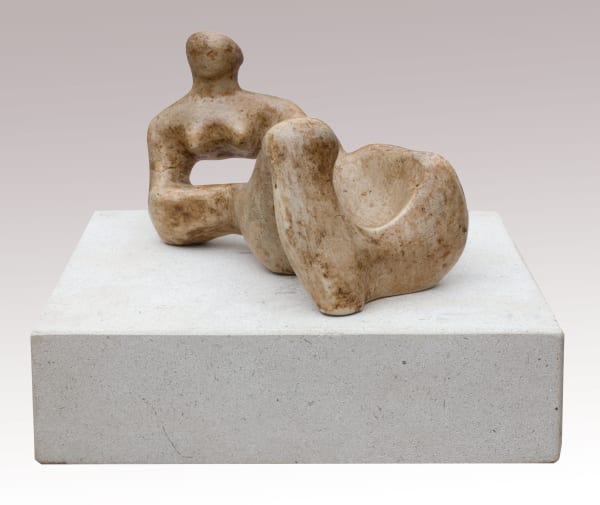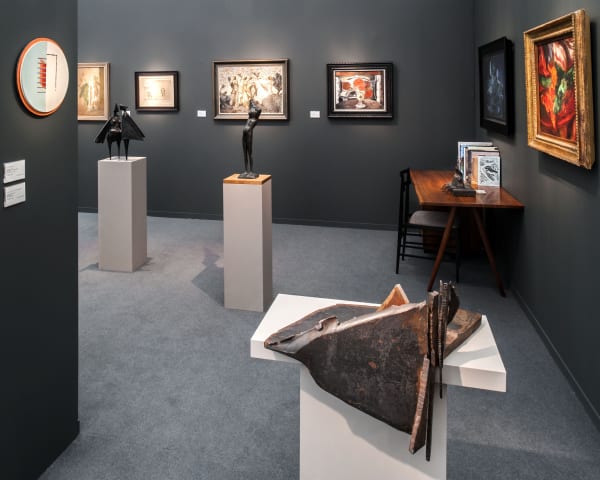Henry Moore
-
 Ideas for Sculpture: Reclining Figures, 1934/1954, c.
Ideas for Sculpture: Reclining Figures, 1934/1954, c. -
 Ideas for Upright Internal/External Forms, 1939-40, c.
Ideas for Upright Internal/External Forms, 1939-40, c. -
 Time/Life Screen: Maquette No. 4, 1952
Time/Life Screen: Maquette No. 4, 1952 -
 Reclining Figure No. 2, 1953
Reclining Figure No. 2, 1953 -
 Maquette for Seated Torso, 1954 (conceived)
Maquette for Seated Torso, 1954 (conceived) -
 Mother and Child, 1956 (cast 1965)
Mother and Child, 1956 (cast 1965) -
 Reclining Figure, conceived 1936-37
Reclining Figure, conceived 1936-37 -
 Maquette for 'Recumbent Figure', 1938
Maquette for 'Recumbent Figure', 1938 -
 Seated Woman, 1959
Seated Woman, 1959 -
 Sheep Drawing, 1972
Sheep Drawing, 1972
Henry Moore (1898 - 1986)
The son of a Yorkshire coal-mining engineer, Henry Moore studied at Leeds School of Art in 1919, after war service in France. In 1921 he won a scholarship to the Royal College, London, where, in addition to his studies, he spent much time in the British Museum. An enthusiastic Modernist, Moore kept in touch with European developments and admired the work of the British sculptors Epstein, Gaudier-Brzeska, and Gill. From 1925 to 1931 he taught at the Royal College during which time, in 1928, he received his first commission, a relief for the London Underground Headquarters which proved controversial because of its 'Primitivism'.
His work of this period, like the Reclining Figure (1929; Leeds, AG) shows the influence of Epstein and 'primitive' Mayan art. During the 1930s Moore was associated with the Hampstead artists, particularly Nicholson and Hepworth whom he joined in the 7&5 Society in 1930 and Unit One in 1933, and moved to Chelsea School of Art (1932-9) which he found more progressive than the Royal College. The abstract biomorphic carvings of this period, including Family (1935; Henry Moore Foundation) and Square Form (1936; Norwich, Sainsbury Centre), are among his most innovative works and, in common with Hepworth, he also explored the potential of the pierced form, a stylistic device which was to bring him notoriety, in the 1930s.
In 1940, through the diplomacy of Kenneth Clark, Moore was commissioned as a war artist and his drawings of sleepers in the Underground during the Blitz are among the most moving records of the Home Front. During the 1940s he established an international reputation which was confirmed by the award of the International Sculpture Prize at the Venice Biennale of 1948. During the 1950s monumental reclining female figures, of varying degrees of abstraction, dominated his work, culminating in the Reclining Figure carved for the UNESCO building, Paris, in 1957. He also produced increasing numbers of modelled and cast figures and through the 1960s experimented with sculptures in several parts, creating tension between the individual elements, as in Double Figure (London, outside Westminster Cathedral). Moore's output, from the 1960s until his death, was enormous and entailed the employment of many studio assistants; public and corporate commissions were matched by the sale of small maquettes, in limited editions, to satisfy individual collectors.
There is no doubt of his stature and significance in 20th-century sculpture. Determinedly humanist, even at his most abstract, his forms evolved to chart human awareness and anxieties in a changing world. Vitality was the quality in sculpture that for him defined success or failure, a force unrelated to traditional concepts of beauty, revealed through the energy contained within the work.
The OXFORD COMPANION TO WESTERN ART
-

The Treasure House Fair
Royal Hospital Chelsea 22 - 26 Jun 2023 Art FairThe Treasure House Fair is a celebration of outstanding and rare art and antiques. Held at The Royal Hospital Chelsea the fair continues the tradition of its predecessors, Masterpiece...Read more -

20/21 British Art Fair 2017
St. James's, London 13 - 17 Sep 2017 Art FairPiano Nobile is delighted to be returning to the 20/21 British Art Fair 2017, which runs from Wednesday 13 - Sunday 18 September.Read more -

Masterpiece 2017
The Royal Hospital, Chelsea 27 Jun - 5 Jul 2017 Art FairStand D19 Piano Nobile is pleased to be returning to Masterpiece for 2017. London's leading arts and antiques fair will be at The Royal Hospital Chelsea from 29 June until...Read more -

London Art Fair 2017
Stand 7 17 - 22 Jan 2017 Art FairThe 29th edition of the fair featured over 130 participating galleries; Art Projects showcasing large scale installations, solo shows and curated group displays; Photo50, the guest curated annual showcase of...Read more -

Masterpiece 2016
Royal Hospital Gardens, Chelsea 28 Jun - 6 Jul 2016 Art FairPiano Nobile returns to Masterpiece for 2016 with Modern British, International and Contemporary art for sale.Read more -

20/21 British Art Fair
Royal College of Art 10 - 14 Sep 2014 Art FairThe 20/21 British Art Fair is the only fair to specialise in British art of the 20th and 21st centuries. Held at the Royal College of Art, 'the spiritual home...Read more -

The London Art Fair 2014
Stand 8 15 - 19 Jan 2014 Art FairLondon Art Fair is one of the UK's premier destinations for Modern British and contemporary art. The 26th edition takes place at the Business Design Centre, Islington, from 15 -...Read more
-

InSight No. 143
Henry Moore | Ideas for Sculpture: Reclining Figures February 16, 2024Like Leonardo, Raphael and Michelangelo before him, Henry Moore was a doodler. He liked to doodle and he doodled with the best of them. InSight...Read more -

InSight No. 123
Henry Moore | Seated Woman April 21, 2023The drawings of Henry Moore convey a sense of three dimensions in two, often equalling or even surpassing the substance and gravitas of the artist’s...Read more -

London Art Fair 2017
The Islington Tribune January 17, 2017Ahead of the London Art Fair 2017, The Islington Tribune featured Piano Nobile as a fair highlight in their coverage for the Arts section of...Read more





























